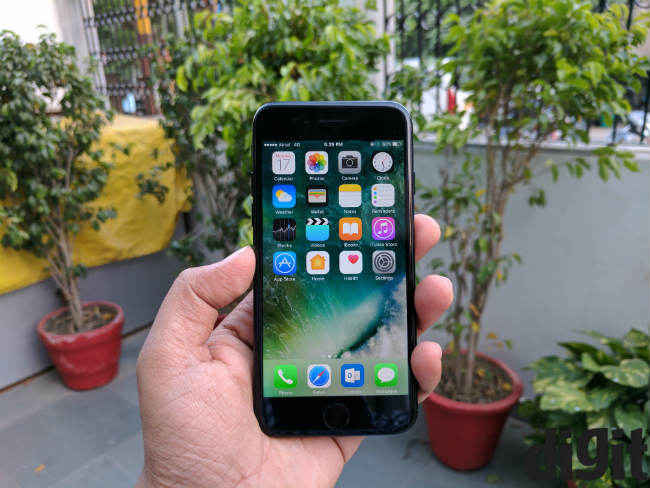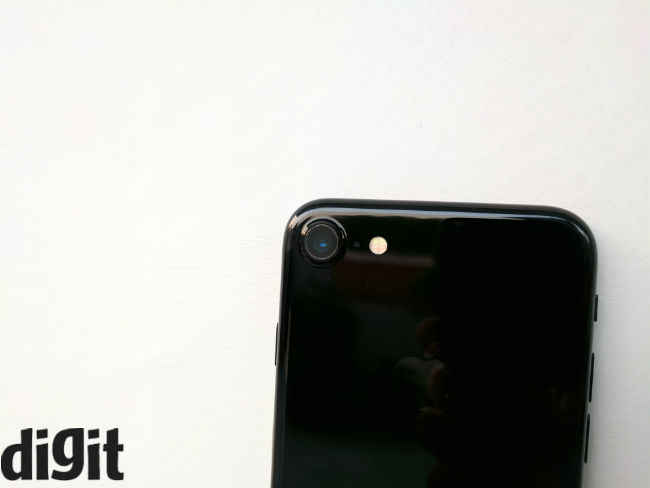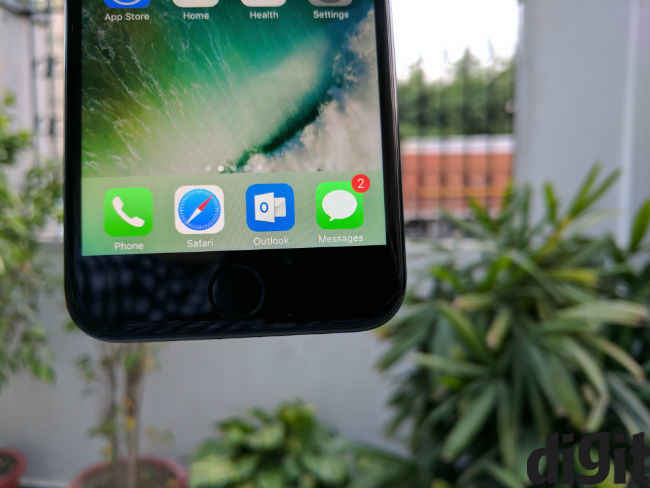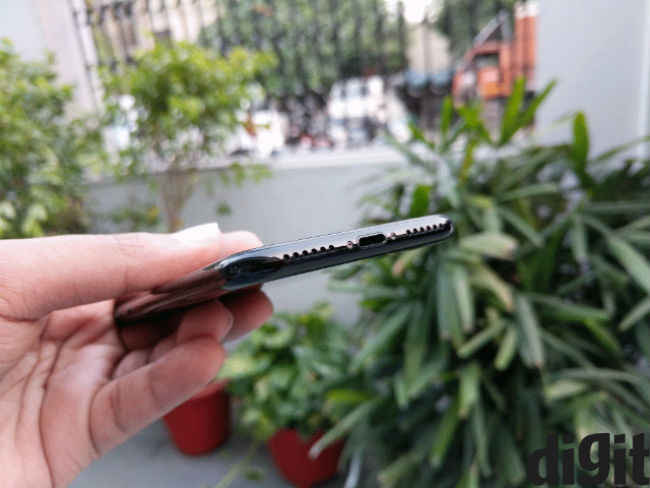Apple iPhone 7 Review : An ode to the future of iPhones
Much like any other iPhone, the iPhone 7 is also a great phone, but it isn't the big upgrade over the iPhone 6S that you may have expected. It's an upgrade for those using the iPhone 6 or below, but we'd still recommend waiting for the iPhone 8 if you can.
Build and Design
Face up, there’s little to differentiate the iPhone 7 from the 6S. At first glance, you’ll be forgiven for not knowing the difference. Apart from the Jet and Matte Black colours, most other design elements are the same, except of course the Home button, which we shall get to, soon.
From the front, there's little to differentiate the iPhone 7 from the iPhone 6S
The major difference is in the back, where there’s a visibly larger camera and flash module. The S branding is also gone.
The main change this time is in the colours. Apple has added two new colours: the jet black and matte black variants. The latter feels pretty much like any other iPhone, but the jet black version is glossy and almost feels like glass.
The jet black variant feels almost glass-like
However, getting a Jet Black iPhone 7 is pretty much useless, since you’ll have to cover it up. As Apple has already warned on its product pages, the Jet Black iPhone does indeed get scratched too easily. In fact, you can see micro scratches even when it’s wiped with a cloth. You don’t want to carry this in your pocket, unprotected.
Personally, I prefer the matte black variant to the jet black version any day. The former feels metallic and is less prone to scratches. The jet black variant is also slippery, especially for those with sweaty hands.
The (lack of a) Home button
It has long been rumoured that Apple is dropping the home button and this seems to be the first indication at that. The iPhone 7 still has a round physical slot below the display, but it’s no longer a button.
The solid home button provides haptic feedback
Apple’s taptic engine allows three levels of pressure. While setting up, the phone tells you to choose one of the three according to your convenience. You can also change this later from Settings. Surprisingly, I found number 3 to be the easiest to get used to.
For existing iPhone users, this takes a bit of getting used to. I kept simply touching the slot, hoping to unlock the phone, but one needs to actually apply force. It’s basically an implementation of Apple’s 3D Touch on the home button.
Frankly, just like 3D Touch, I find this to be a forced addition. It seems like a change for the sake of change. The taptic engine doesn’t make this any better than a physical button. In fact, it makes things worse by adding a learning curve. You also need to make skin contact with it, so no, it won’t work with gloves on.
However, if this means Apple can get rid of the whole button in future and cut down the top and bottom bezels, I’m all for it. The iPhone is quite compact, but it’s hardly the optimal size. A 4.7-inch phone could be much more compact and easy to use, were it not for Apple’s penchant for symmetry.
According to some reports, Apple even has an onscreen solution in case the new taptic button malfunctions. It all points to a whole new shift to the way Apple wants to implement the Touch ID and its famed home button.
The (lack of a) headphone jack
Yes, the headphone jack is gone now, and only once did I really feel it. I think the outcry over its omission is warranted, but really, the world is indeed moving to wireless. I played music on Bluetooth speakers and the Sony MDR-1000X, and other wireless headphones also work just fine with this.
Goodbye headphone jack
In fact, my Audio-Technica CKX9 worked fine with the provided convertor as well, with no noticeable loss in audio. In short, you don’t need courage to buy this phone, you just need good memory. Don’t lose the lightning convertor and you should be fine.
Display
The display seems like another nod to existing rumours. The colours and feel of the iPhone 7’s display is very OLED-like. Incidentally, Apple is expected to bring an OLED display to the iPhone 8 next year.
That of course means that the new display is warmer, but to Apple’s credit it’s not oversaturated like OLED panels. It is also not an OLED panel. The iPhone 7’s display is just an LCD panel that’s very good to look at. The contrast is higher than the iPhone 6S, which makes up for the marginally lower brightness. Our luminance meter gives a reading of 714 Lux against the 6S’ 800 Lux. As with any iPhone, though, the auto-brightness makes you forget the brightness control.
According to Apple, the display supports a wider colour gamut now, and that’s quite evident. One just needs to put the same photo on the iPhone 6S and iPhone 7 to know the difference. The display on the iPhone 7 is much more pleasant to look at. In fact, even the touch feels smoother, but that could just be because my iPhone 6S is now a year old.
Performance
Not many will overpower an iPhone when it comes to raw performance. Apple’s vertically integrated software and hardware have routinely clocked the top scores on our benchmark lists. That said, this is the first iPhone to sport a quad-core processor, and it has 2GB of RAM, just like the iPhone 6S. Together, this makes for a formidable combination.
That said, while the iPhone 7 is faster than the iPhone 6S, I wouldn’t exactly call this an upgrade in practical terms. Even though the A10 Fusion chip is decidedly faster than the Apple A9, the high power cores seem to never come into play when running regular apps. In addition, gaming is as smooth as ever and even the heaviest games take less than 10 seconds to load on the iPhone 7, just like they did on the iPhone 6S.
To be clear, the iPhone 7 is indeed faster than the iPhone 6S, but don’t be surprised if you don’t see it. Apps don’t use the kind of performance the iPhone 7 provides right now and it’s possible that the phone is too powerful for its time, which is an indication of the future of iPhones.
Interestingly, despite its speed, the iPhone 7 never became too hot either. I could register a maximum temperature of 38.4 degrees Celsius. The thermal control mechanisms seem to start controlling the heat quite easily, but even a throttled processor churns out good enough performance to avoid noticeable lags. The temperature rises above 40 degrees only when you're recording 4K video, and it takes about 9 minutes to do so.
What’s far more realistic about the iPhone’s performance is how seamlessly it shifts from one WiFi to the other, or from WiFi to mobile data. Even signal reception is better, the iPhone gets better coverage in my house, compared to most other phones I review. My home is a perpetual dark spot for network coverage, and I’ve seen only a few flagships that get good enough reception.
Camera
The iPhone 7’s camera has a wider aperture than the iPhone 6S. The former has a f/1.8 aperture against the 6S’ f/2.2. Barring the megapixel count, almost everything about the camera has changed, including the algorithm. The iPhone 7 has a new 12MP sensor, and optical image stabilisation. According to Apple, the omission of the headphone jack allowed the larger sensor and OIS, and they’ve paid off.
However, the difference between the 6S and iPhone 7 is only noticeable on low light performance. The iPhone 7 achieves faster shutter speeds thanks to OIS and keeps the ISO low, providing less grainy images. However, in many low light shots, the iPhone 6S created finer grains, allowing more post processing. The iPhone 7, however, produces distorted noise, which sometimes makes images look bad. Also, the iPhone 7 clips highlights in some reasonably and well lit conditions.
You’ll find a detailed analysis of the iPhone 7’s camera in this comparison with the iPhone 6S.
As a standalone camera, the iPhone 7 is great, and images also appear warmer than earlier Apple phones. Under well-lit conditions, the phone produces very good colours and really good detail. It’s up there with any flagship camera you can think of today, but one has to wonder whether not having the dual-camera on the iPhone 7 makes a difference. After all, why should the only truly new iPhone feature not be on the smaller iPhone?
Battery
Like many iPhones before this, the battery remains a point of contention for me. While the iPhone 7 could last me a work day, there have been too many Android phones that do better. With gaming, camera and regular social networking, calls etc, I got a best of about 16 hours from the iPhone 7. Now, this is indeed better than what the iPhone 6S gave me, but it’s not ideal battery life.
The 1960mAh battery on the iPhone 7 does well considering its capacity, but one may still want more. Apple claims an hour’s worth of battery life over the 6S, and that seems just about right.
Bottomline
The iPhone 7 is indeed a powerful phone. It also has a pretty great camera, but I can’t call it an upgrade over the iPhone 6S. If you have one, hold on to it. To me, the iPhone 7 signals a new era for iPhones to come. It is indeed an upgrade over an iPhone 6, but I’d still recommend holding on to that one and buying the iPhone 8 next year. Apple is evidently making changes, from UI to hardware, and there are greater things to come.
If you have the money to throw, sure, buy this. However, it’s not worth upgrading an iPhone 6S for this one.




